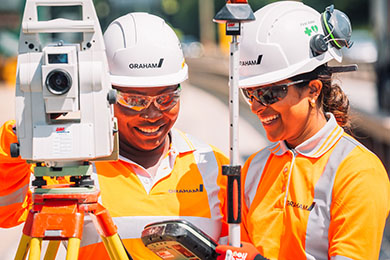

GRAHAM Construction recognised that its workforce’s priorities had changed over the last few years, with personal well-being and a better balance between work and home life being more important than ever. Here’s how we helped to introduce more flexible working practices across the Civil Engineering division.

GRAHAM is a privately owned Construction and Facilities management company with 16 regional offices throughout the UK and Ireland, with 2,500 staff. Its Civil Engineering division specialises in resolving complex engineering challenges, from easing commuter congestion to powering renewable energy.
The challenge and opportunity
GRAHAM’s workforce already had a degree of informal flexible working and, having read our report – Making construction a great place to work – wanted to understand how to extend this further to all teams through engaging the site-based managers. Recognising the shift in expectations for more agile working, and understanding that it would be key to staff retention and recruitment, GRAHAM’s leaders were keen to bring about change as quickly as possible.
In the past, objections to introducing flexible working practices within the construction industry have centred around the need to maintain health and safety standards, being unable to offer any level flex to all roles, meeting commercial targets and managing sub-contractors and suppliers.
“The construction industry is very traditional in its approach to working, but we want to challenge this and demonstrate that flexibility can be integrated without compromising on delivery for clients or financial performance.” Michael Smyth, HR Director GRAHAM Group
Our solution
While there was broad enthusiasm for change across the organisation, there were some initial pockets of reluctance, largely due to a concern that there was already enough to do without having to manage new working patterns. Our position as external experts, and collaborative approach, were considered key to overcoming this barrier.
Working closely with the GRAHAM Human Resources team, we explored two options; running an in-depth pilot program with a small part of the business, or providing training and support for managers more broadly across the Civil Engineering division, so they could initiate their own flexible working pilots.
We concluded that the best route was to implement a top-down approach by engaging the team managers. This would allow them to adapt their learnings to their own teams’ circumstances and overall objectives.
“In order to fast track the benefits of more agile working patterns, we partnered with Timewise. Their consultants took the time to understand our objectives, working with us to develop an adaptable model that fitted with our business needs, but which was also easy to implement for managers on the ground.” Michael Smyth, HR Director GRAHAM Group
The process
We began by designing a series of regional workshops for site-based managers, to share real-life examples of how flexible working can be successfully implemented for construction workers.
As well as sharing our experience and expertise from our work elsewhere in the sector, we also highlighted examples of where flexibility was already taking place informally at GRAHAM. Sharing these examples helped bring the discussions to life, highlighting arrangements that were working well and opening up conversations about how to build on them.
The rate of change in attitudes towards flexible and hybrid working within the industry has outstripped that of many team managers, so hearing relevant success stories from colleagues, as well as our third-party expertise, was key to opening minds to the potential benefits.
Overall, the workshops demonstrated clearly that, despite people’s fears that working flexibly might negatively impact the project, it actually benefitted it, by helping workers become more engaged and productive.
Learnings and outcomes
The workshops really helped overcome negative preconceptions of flexible working, with the majority of attendees immediately seeing the value of offering it to their teams and understanding how even small changes can make a big difference to individuals.
At the end of each workshop, all attendees agreed to commit to doing at least one thing to work towards implementing flexible working in their own teams. To support this, this, we also built guidelines for Civil Engineering managers to use on site as they evolved their ways of working. This was all brought to life with anecdotes from our previous pilot work within the sector.
GRAHAM continues to review their operations, collating their learnings for ongoing review. This will help managers to see the value of flexibility, which has already resulted in lower staff turnover and increased engagement rates.
The client’s view
“We are an innovative employer and recognise that creating a modern working environment leads to personal and business benefits. Timewise’s holistic approach means ongoing support beyond the project with access to their peer community. Creating change won’t happen overnight but with the ongoing support, innovation and advice from Timewise, a modern working culture will emerge.” Michael Smyth, HR Director GRAHAM Group
Published January 2023

The place-based rise in flexible working that evolved during the pandemic has passed frontline workers by. Whilst most office-based employees were, and still are, able to work from home, those who have to be based at a specific location didn’t have that flexibility. And the hype around ‘hybrid working’, and its conflation with ‘flexible working’, have taken attention and resources away from other kinds of flexible arrangement.
The figures are pretty stark: frontline and place-based workers, a category which includes roles as diverse as medical staff, transport workers, teachers, cleaners, retail assistants and construction workers, make up almost half of all UK employees. And yet just 3% of shift workers, which many frontline employees are, have any flexibility in their role.
The result is the risk of a two-tier workforce, split into flex haves and have-nots, in which those who can work in a hybrid way have easy access to flexibility, while those who work in frontline and placed-based roles (which are more challenging to make flexible) are left to struggle on without it. And this is increasingly having a knock-on effect on recruitment and retention, as people who want or need flexibility seek it elsewhere.
But here at Timewise, we know that it IS possible to make place-based and frontline roles more flexible. We’ve carried out pilots in teaching, construction, nursing and retail that explored how innovative job design can create some flexibility around when and how much people work. And we have also shown that investing in flexible working in frontline sectors pays for itself within just a few years, through improved retention and sickness absence. We invited leaders from a range of frontline sectors to come together to talk and learn from each other, discussing the challenges they are facing, the actions they have taken and the outcomes they have achieved. Here are the key themes that came out of our discussion.
Aside from the obvious logistical challenge that remote working is rarely an option for place-based roles, there are some other key issues and barriers that our attendees noted:
The battle for talent against more attractive roles elsewhere
Many frontline industries are struggling with staff shortages – from nursing and care work to construction and engineering. And the reasons why are varied, including rates of pay and unsociable hours or shifts. These both prevent people from wanting to join the industries, and make them more likely to leave.
However, offering some kind of flexible working can help mitigate the ‘brain drain’. It’s been shown, for example, that many teachers who leave for another profession reduce their hours. So making time-based flexibility available within these roles could encourage them to stay on, delay their retirement or join in the first place.
The impossibility of offering the same flex to everyone
Clearly, someone working in an on-site role can’t spend their entire time working from home. So organisations which have a combination of office-based and frontline roles won’t be able to offer everyone the same arrangement. This can be hard when employees look at the flexibility others are getting and want the same.
Some organisations are dealing with this by trying to bring their hybrid employees back into the office, for the sake of solidarity with their colleagues. We’d argue this isn’t the right approach, and only makes sense if it would benefit the on-site colleagues and make a real difference to the team as a whole. Instead, the key is to look at what flexibility CAN be offered within the frontline roles.
‘We’ve always done it this way’
The status quo can be a real barrier to innovation. Sometimes there are structures and processes within an organisation that seem set in stone, without anyone having asked why, or what else could be done instead.
One example cited by an attendee was a local authority’s bin collection service, which had always started at 6am. No one knew why it was scheduled so early, or could think of a good reason why it should stay that way, so they changed it to allow flexibility around start times. Levels of service were unchanged and there were no complaints from residents or employees.
The role of clients and the supply chain
Another factor that frontline organisations have to consider is the demands of clients, customers and the supply chain. For example, if clients expect on-site teams to be available at all hours, or suppliers feel they can deliver whenever they like, it can make it harder to facilitate time-based flexibility.
It’s true that these are factors that need to be worked around, but it can be done. Setting clear expectations with clients at the beginning of a project, for example, makes it possible to move away from industry norms.
The need for industry-wide change
Underpinning this point, as, one attendee noted, is that that some leaders, managers, suppliers and clients have such entrenched mindsets that it will take an industry-level shift to overcome them. We agree, which is why we make a point of carrying out projects and pilots across an industry, usually in partnership with four or five organisations and supported by industry bodies.
For example, we rallied four construction pioneers to work with us on an action research project, supported by Build UK. This allowed us to research, test and trial new approaches for on-site staff, and share our learnings widely. We’ve carried out similar projects in teaching, retail and the NHS.
So, with the above challenges in mind, how can frontline organisations get better at flexible working? Here are some things to consider.
Involve your staff in the process
Begin by exploring what flexible working means to the people in your organisation. While they may understand more common arrangements like part-time and hybrid working, they may not be aware of what else could be possible for their role.
Finding out what the main outcomes they want to achieve from flexible working is a good place to start. It could be as simple as being able to drop off or pick up a school-aged child, a broader issue around work-life balance, or something else entirely.
For example, one of our attendees realised that a top focus area for their employees was career progression and development. They therefore developed a model that included two hours a week from home to achieve this.
Another attendee spoke about running workshops for employees to discuss their needs and wants, which resulted in staff being given one day in every 20 off, and the establishment of core hours outside which people were not expected to respond to emails.
The process is almost as important as the outcome, because involving your employees in the discussions will ensure they feel heard, understand what can and can’t be done, and feel ownership of the solutions.
Invest in job design to explore viable options
Once you know why people want to have more flexibility, you can then look at how to match the flex you can offer to their needs and role. At Timewise, we have developed a ‘Shift-Life Balance’ model which helps frontline employers explore issues around input, stability and advance notice to develop appropriate workloads and patterns.
It’s worth remembering that sometimes, a small change is all it takes to achieve the better balance an employee is seeking. One attendee noted that allowing employees to start just one or two hours later was enough. Another highlighted the feeling of ownership and fairness that employees gained from having input into the rosta, rather than having it imposed upon them.
We ourselves found in our construction pilot that simple changes such as altering the timings of site briefings, and developing a pattern of rotating shifts, made a surprisingly big difference.
Look at changing practices to boost productivity
If you’re willing to move on from ‘we’ve always done it this way’, it’s possible to rework your processes and practices to achieve the same in less time. One attendee described a unit who are paid on the number of jobs they fulfil in a day. They make their own choices about how best to achieve that target and have become more productive as a result.
Another noted that, having introduced some flexibility, “There has definitely been a positive impact on productivity. Morale is much better, and the guys are working harder.”
Upskill managers and embed a culture of trust
Finally, none of these measures will land unless you have established a culture in which people’s lives outside work are respected, and they are trusted to do their best work. And they won’t work in practice unless line managers are trained and encouraged to see them through.
So it’s vital that your leaders set the tone that flexible working is good for the organisation, and should be championed at every level. And it’s worth investing in upskilling your managers to design and advertise flexible roles, and manage flexible teams. This doesn’t mean saying yes to every request; but it does mean creating a collaborative process in which all the options can be explored so that some kind of flexibility is available in every role.
As one of our attendees noted, the talent challenges within frontline roles mean that organisations are going to need to be brave, strike out and do things differently and lead the way for others to follow. If that sounds like you, we’re right behind you; do get in touch if you’d like our help.

Employee well-being is a workplace issue that desperately needs tackling. In the UK, a huge number of working days are lost to ill health (32.5 million in 2019/20) and stress, depression and anxiety (18 million). We know that flexible working can support employee well-being – but we also know there isn’t a one size fits all solution.
While the pandemic helped focus leaders’ attention on their employees’ well-being, and normalised the concept of working from home, it also had some negative effects, as people struggled to keep their home and working lives separate. And critically, the changes driven by the pandemic have happened in a reactive way, rather than a proactive one.
Additionally, we are now in a new, also difficult era, dominated by the cost of living crisis. Right now, financial issues are affecting the well-being of many employees, and employers are increasingly willing to think creatively about how they can offer support.
The result is a ‘golden window’ in which businesses are considering the health and well-being of their staff more than ever before. So we invited three business leaders to join us to discuss this at our recent roundtable: Richard Martin, Executive Officer of the Mindful Business Charter; Rebecca Ormond, Inclusive Workplace Leader at PWC; and Jordan Cummins, the CBI’s first Director of Health.
So, what should employers do to boost employees’ well-being in the current climate? Here are the key themes that came out of our roundtable discussion.
Review pandemic-driven decisions – and make changes where needed
The new, more flexible ways of working that evolved during the pandemic were often brought in at speed. And while they have been positive in many ways, they can also be a barrier to well-being.
For example, the removal of the boundaries between work and home has led to an expectation of being always on. And while some employees relish skipping the commute and getting more time to spend with family, there are others who feel burnt out by work creep, and miss the connections that being fully office-based brought.
Similarly, while hybrid working is seen by many as the best of both worlds, it is not without its problems. There is a risk of two track workforces developing, in which those who continue to work from home are sidelined, affecting their well-being as well as their careers. Research from the CMI indicate it’s already happening, with 40% of managers saying they have observed opinions or behaviours suggesting inequality between those who work in a hybrid way and those who don’t.
Employers should therefore take a proactive look at how decisions made during the pandemic are affecting employee well-being – and make changes where needed. This includes supporting employees to reinstate the boundaries between home and work, and taking action to ensure that the flexibility on offer is fair and inclusive. The result will be truly flexible working arrangements that benefit both the business and the employee.
Increase your understanding of your employees’ circumstances and needs
A key part of this review – and of creating sustainable well-being strategies going forwards – will be to understand what issues people are dealing with and how the business can help.
Gathering data on well-being can be hard, but people are increasingly willing to disclose details about their circumstances – and will be even more so if they understand that this may lead to greater flexibility. Set out a framework of information you think would be useful to gather, and pulse check regularly.
Shift your approach to well-being and become a prevention workplace
The positioning of well-being within an organisation is central to its success. One positive step to take is to stop treating health and well-being as a cost, and instead consider it as an asset to be invested in, like sustainability.
This will lead to well-being being seen as a competitive advantage, rather than a burden, and help you focus on preventing poor well-being, rather than reacting to it. Ideas for supporting this include:
And of course, proactively offering well-designed flexible roles, which allow employees to better balance their work and home lives, is central to being a prevention workplace.
Encourage a culture of openness and trust between line managers and teams
Building on the above, line managers should be encouraged to have open conversations about well-being with their team members. It’s a big leap for many managers to go from talking about workload to talking about well-being, but it becomes easier once a culture is established in which these conversations are not only acceptable, but preferable. Things to think about:
It’s worth remembering that most employees want to achieve and do their best at work; the business simply needs to trust and support them to do so. And that includes exploring which kinds of flexibility will make that possible.
Explore the impact of the way your organisation works
As well as putting initiatives in place to support well-being, it is also important to look at your structures and processes; in reality, it’s often the way people work that creates stress. This includes the nature of the work itself and organisational expectations, as well as how individuals interact.
A key part of resolving this is to develop a company-wide conversation about how your team members are working with each other. Then act on it in your structures and processes. For example:
Again, little things can make a big difference; thinking about when you schedule meetings, or even send emails, can reduce stress and underpin your commitment to flexible working.
Address the impact of the economic crisis clearly and swiftly
Whilst employers are not responsible for the cost of living crisis, they do have a duty to support their employees to navigate it as best they can. And being clear in communications is absolutely critical. Observations from our panel included:
Of course, this kind of support doesn’t have to be limited to a financial crisis; some companies are already looking at how they can support their employees’ financial wellbeing. Initiatives include offering pension planning to parents and carers who have taken career breaks, or providing a financial well-being expert who can explain what benefits are available and how to access them.
It’s also worth noting that part-time opportunities can support financial well-being. Offering high-level part-time jobs within your organisation could help parents, carers and others who can’t work full-time to progress their careers and increase their incomes. And doing the same when recruiting could open doors to help others back into the workplace (as well as widening your talent pool).
With learnings from the pandemic ripe for analysis, and the cost of living crisis likely to continue, it feels like the right time for employers to develop and embed their commitment to employee well-being. For the best chance of success, flexible working should be at the heart of any approach; if you need support with this, please do get in touch.
Published October 2022
By Muriel Tersago, Principal Consultant

Debates around the crisis in teacher recruitment and retention aren’t new – but the pandemic appears to have made things even worse. April 2022 research from the National Education Union suggests that 44% of teachers are planning to leave within five years, and that it’s getting harder to fill vacancies, with a knock-on effect on workloads for remaining staff.
Teachers’ reasons for leaving are many and varied, and include issues around workload, wellbeing and stress; all of which could be mitigated if flexible working in schools was more widely available. Indeed, NFER research has shown that some teachers leave because they can’t access flexible working, and that many secondary school teachers who do leave reduce their hours when they do.
It’s for this reason that we have spent the last 16 months working on a Teaching Pioneers Programme with three MATs, across eight schools, piloting how best to champion and deliver flexible working within schools. And our findings are clear: yes, it’s complex, but it’s not impossible, and there is a return on investment for doing so. As one deputy headteacher put it: “Find the commitment and shift in mindset, and you can tackle the operational issues.”
Clearly, introducing flexible working into teaching is less straightforward than in office-based roles. Complications around timetabling and culture, the frontline nature of the role and the intensity of the school day all play their part.
But our Teaching Pioneer MATs (Academies Enterprise Trust, GLF Schools and The Kemnal Academies Trust) recognised that these challenges should, and could, be overcome. They agreed about the benefits of flexible working in schools, and saw our pilot as an opportunity to focus on how to go wider and deeper with the changes that were needed.
Our team worked closely with central HR teams and headteachers from the eight schools to explore five core areas, providing support including workshops, coaching sessions, timetabling masterclasses and train-the-trainer materials, and sharing learnings across the group at each stage.
So what was the outcome? There were a number of key learnings, which our Teaching Pioneers have already begun to implement – and which can be adopted by other schools and academy trusts who are keen to get better at flexible working. Here are some of the highlights:
Many schools currently operate on a request-response model, in which people (usually women coming back from maternity leave) formally ask for reduced hours. This pigeonholes flex as something that needs to be earned, and isn’t applicable to all, creating an unspoken sense that there are a limited number of arrangements possible.
A far better way forward is to implement a proactive whole-school approach, which opens up opportunities for flexibility across all roles. This is facilitated by regular, open discussions about what people’s flexible needs might be, how to create opportunities to support these, and how to build these into the timetabling and workforce planning processes.
A knock-on effect of the request response model is that flexible working in schools has become synonymous with part-time. However, there are many other flexible options that schools can consider, such as timetabling PPA at the beginning or end of the day and allowing staff to do that work from home, or delivering CPD and meetings remotely.
Many schools trialled some of these approaches during lockdown, and some have continued with them; but what’s often missing is a strategic approach to their implementation, underpinned by dialogue about when, where and how work can be done, which gives people a sense of input and control.
The point is to have open minds and discussions, and see what is possible within each role and team. In the words of one principal: “We can’t guarantee the same outcomes… but the process is the same for all – open conversations, trying out different ideas and trying to make it work.”
Clearly, such substantial operational and culture changes require committed leadership. So it’s vital that headteachers are not just vaguely supportive of flexible working, but committed to it in principle, and driven to make it work. This commitment is all the more powerful when heads role model working flexibly themselves.
They also need to be willing to pass on some of the responsibility to others. With a whole-school approach, the implications and execution of what’s needed and what’s possible are discussed at an individual, team and school level, rather than simply being approved or declined by the head.
The pilot also highlighted the importance of clear communication, explored solutions for the thorny issue of timetabling, focused on training and empowerment of line managers and noted the positive impact on students.
Sixteen months on from the start of the project, what’s been the impact on our Teaching Pioneers? Our post-pilot evaluation showed that a majority of teachers surveyed felt more confident about discussing flexible working, and that different reasons were considered more acceptable; they also noted that their schools were increasingly supportive of flexible working.
Qualitative feedback also highlights the impact the programme has had. Comments include: “There is so much goodwill in return for the trust and understanding we are given”, and “Thinking proactively is liberating… we engage more people to explore what’s possible and come up with more creative ideas that can work for both sides.”
One principal noted “Our absenteeism has dropped through the floor”, which highlights the return on investment that flexible working can deliver. Our own research has showed that, for a MAT with 100 teaching staff, one fewer sick day per teacher per year for three years would cover the cost of a flexible working pilot. On every level, that’s an investment worth making.
It’s our hope that more schools and MATs will use the findings from this pilot to develop their own whole school approach to flexible working, and reap these rewards. We’ve also partnered with the Department for Education to develop a programme of insights and resources to train school leaders in flexible working; to date 682 schools and 103 business institutions across the country have taken part. We’ll be watching with interest to see how the educational landscape changes as a result.
You can download the Teaching Pioneers Programme report here.
Published June 2022

The suggestion that under a hybrid model, it will be women who predominantly opt to work from home, to the detriment of their careers, is understandable from a statistical point of view. Data from 2018 suggested that two thirds of mothers are the primary carer for their children. And during the pandemic, women carried out two thirds more of the childcare than men.
But it’s not that simple; and employers who assume it is are doing themselves and their other employees a disservice. The fact is, there are groups other than parents for whom working from home may also be a preference. And for some, lockdown-enforced remote working actually levelled the playing field in terms of access, availability and visibility.
For these groups, being supported to work from home without being affected by proximity bias is essential; badly thought-out hybrid arrangements could send their inclusion backwards. Here’s a look at some of these groups, and why it is in employers’ interests to make sure they’re properly included.
It’s been noted that autism is associated with characteristics such as loyalty, honesty and productivity, as well as logical thinking patterns and creative thinking skills, all of which are hugely valuable to employers. But for people with this condition, and others such as dyslexia, dyspraxia and ADHD, the office environment is not necessarily conducive to working.
For example, office lighting and acoustics can be tricky to navigate for people who struggle with sensory overload. And the social aspects of the workplace, and the battle to commute, can be exhausting for those who don’t find interaction easy.
So working from home, at least some of the time, could help these employees stay focused, and produce their best work. This is particularly the case if they are supported to work remotely in a way that suits their preferred communication method – for example, audio-only may work best for some team members.
From access issues for employees who use wheelchairs, to cancer patients’ need to attend appointments during the working day, working from home can minimise some of the complications that employees with physical health issues have to juggle. It also frees up time and energy (which they may need to use sparingly) for them to focus on doing a good job.
And with recent reports suggesting that fewer than one in three patients who were hospitalised during the pandemic feel fully recovered a year later, there is every indication that long Covid may become a real issue for employees. The ability to work from home will be key to helping them stay in the workforce.
It’s also worth remembering that some illnesses aren’t physical, or visible; the needs of employees with mental health challenges must also be taken into account. For employees with depression or anxiety, there’s no one-size-fits-all; but being able to work in a calm quiet space at home may be gamechanging for some, reducing stress levels and supporting the production of high-quality work.
And given the impact the pandemic is having on mental health – with ONS data from May 2021 revealing that depression rates had doubled since it began – a growing number of employees are likely to be affected in this way, and require support from their employers to thrive.
According to Carers UK, the Covid-19 pandemic has seen the number of employees with caring responsibilities rise dramatically, with the proportion of carers in any workforce now one in four.
For these employees, working from home can mean being able to visit or support their relative in their lunch hour, or at times when they would otherwise have been commuting. This has a positive effect on their own wellbeing and stress levels, which in turn, affects their ability to deliver for their employers.
Clearly, then, being able to work from home at least some of the time is a bonus for many members of these groups. And the impact that this has on their ability to deliver is good for their bosses, too. But there’s much more to it than that.
Diversity and inclusion isn’t just a box-ticking exercise; there are good reasons why organisations should aim to include a variety of experiences, viewpoints and skills. It opens them up to a broader range of perspectives and opinions, limiting the risk of groupthink and bringing more unique ideas and solutions to any given problem. It contributes to creativity and competitiveness; offers access to a wider talent pool; and makes it easier to get the right skillset for the job.
So what does all this mean for you? It means that if you want a diverse, inclusive workforce, whose employees offer an equally diverse range of skills and experiences, you need to create a culture in which they can thrive.
That means understanding your employees’ individual circumstances – remembering that not all challenges are visible. It means taking the time to understand what working arrangements will help your people to do their best work, and designing solutions that ensure that everyone is included. Training and empowering managers to have 1:1 conversations with their team members about workplace flex is a key part of this.
And in today’s Covid-affected landscape, it means deliberately working to mitigate against proximity bias, putting processes in place to make sure that people who are in the office more frequently don’t receive preferential treatment. If you’re not sure how to design inclusive hybrid working arrangements, we can help; do get in touch to find out more.
Published January 2022

By Amy Butterworth, Consultancy Director, Timewise
After nearly two years spent working in pandemic conditions, it’s time for leaders to review the successes and challenges they’ve experienced with flex and make concrete improvements for the future. Taking a few simple steps now will help turn concerns about the great resignation, the two-tier workplace and fragmented teams into opportunities to create a motivated, cohesive workforce.
During the pandemic we’ve bounced backwards and forwards between working from home and returning to the office. It’s felt chaotic and stressful, but the upside of this uncertainty is that we’ve experienced a variety of new working patterns. Now is an ideal time to be candid about what is – and isn’t – working for your team.
The resolution: Implement a specific plan to improve flex working
Set an honest, collaborative tone by consulting with your teams on their experiences and openly sharing the constraints you’re facing. This will allow you to decide on and implement clear, measurable actions to meet these challenges. Could a change in working hours or regular, virtual 121s help flex work more smoothly? Find the processes and patterns that will make your resolution stick and commit to reviewing them regularly.
2. The challenge: Address the imbalance of a two-tier workforce
Thanks to the swift introduction of working from home, many companies are being confronted with an unintended, unequal two-tier workforce and the dissatisfaction that can bring. Frontline workers who are required to be present in the workplace can easily feel resentful towards the hybrid workers who remain at home without having to spend time or money commuting.
The resolution: Expand your flex working options
Hybrid working should not be the only flexible working option available to employees. It places those on the frontline in industries like catering, transport and tourism at a significant disadvantage. Forward-thinking companies now offer flexibility around the timing and amount of work undertaken, as well as the location. One of our clients realised their hybrid working plans wouldn’t suit their entire workforce so they now plan to trial part-time working, flexible shift patterns and the option to work anti-social hours as well.
3. The challenge: Engage detached, disheartened teams
Despite everyone’s best efforts, the last two years have seen the cancellation of team-building events and parties alongside the abandonment of communal office spaces, leaving workers feeling increasingly detached from their managers and colleagues. Maintaining shared goals and a sense of camaraderie is key to achieving targets and engaging employees – so what can be done?
The resolution: Set aside time to connect with your employees
The intensification of work has made it tempting for leaders and managers to spend the time that would have normally been spent on physically engaging with their teams on other tasks – but that’s a mistake. Even when you can’t bring people together in person, you need to ring-fence that time and find alternative ways to engage with them instead.
This could include simple day-to-day actions, such as building informal catch-up time into your virtual meetings and allocating team ownership for activities and goals. It could also be through fun, creative ideas such as learning circles, gif battles or online lunch dates. To engage a flexible workforce and improve team connection, you’ll need a range of in-person and virtual options.
4. The challenge: Ensure hybrid workers aren’t overlooked
Out of sight, really could mean out of mind when it comes to career progression for hybrid workers, particularly women who often combine flexible working hours with family and caring duties. LinkedIn has found that a third of UK business leaders and nearly half of UK workers are concerned about the favouritism of proximity bias – the tendency to promote workers visible in the office at the expense of those working from home.
The resolution: Give hybrid workers a clear career plan
To make sure hybrid workers have a fair chance of promotion, spend longer than usual defining, “what good looks like” with them and make sure you set measurable outcomes-based objectives. Challenge yourself to reward and recognise people for the outcomes they achieve rather than the number of hours they are present in the workplace.
5. The challenge: Turn the great resignation into a great opportunity
Triggered by a dramatic increase in remote working options, the great resignation of workers who quit their jobs in 2021 to find more flexible options looks set to continue. Rather than looking on this upheaval as a negative, this change to the working landscape can offer an opportunity for employers to attract loyal and highly skilled talent.
The resolution: Shout about your flex options to attract new talent
Design any jobs you’re advertising with flexible working built in, and make it obvious which options are on offer – whether that’s homeworking, part-time, variable hours or an alternative. Promising a vague flexible working culture is simply not enough to gain the trust of potential employees.
Action any or all of these resolutions and you’ll be well-placed to build a robust, motivated and united team, ready to take on whatever this year may bring. At Timewise we can equip you to create a successful flexible working strategy for the future of your business so you can thrive in 2022 and beyond; contact us to find out more.
Published January 2022

Big Society Capital exists to improve the lives of people in the UK through social impact investing. They unite ideas, expertise and capital to create investment solutions for the UK’s social challenges, supporting organisations that deliver both positive social impact and sustainable financial returns. The company has around 75 employees, with an office in central London.
Leaders at Big Society Capital have long been keen to ensure that their staff work in a way that fits with the rest of their lives, and helps them do their best work. 25% of employees work part-time, and the company is currently working to a hybrid model, with employees spending between 20% and 40% of their time in the office.
The HR team at Big Society Capital wanted to find a middle way between employees putting in formal requests for flexible working and having an informal chat. They were also determined to build on the positive learnings from the Covid-19 pandemic, and make sure they were firmly embedded.
Big Society Capital were aware of our long-held expertise in this are and sought our advice on the best approach.
Our team worked closely with the HR lead to explore the different options available. This included discussing a range of ideas and sharing examples of good practice from our other clients. We concluded that the best approach would be to create a framework and principles for discussion.
We collaborated with the team to create these, and received positive feedback and approval from the Executive Committee. Additionally, we sought feedback from managers, to check that they would work in practice, and delivered training on how best to implement them.
At the time of writing, the framework and principles are still relatively new. The HR team are committed to evaluating them on a regular basis and making any tweaks that are necessary. Plans include a formal evaluation through their next employee engagement survey, and a review of the number of formal and informal requests taking place following the change.
Anecdotally, the framework and principles have been well received. The team have put in place regular surgeries for staff to come and ask any questions they may have about how to use them.
The client’s view
“If you have a small HR team, having external expertise and support is incredibly helpful when you’re creating a new set of working practices. Amy was brilliant; she gave a huge amount of coaching, advice and feedback, and her depth of knowledge and insights from other organisations on what works meant we developed a really robust framework and principles which I’m confident will succeed.” Julia Boddy, Head of HR, Big Society Capital.
By Amy Butterworth, Principal Consultant, Timewise

There’s a growing sense out there that it’s time to start bringing people back into the office. With restrictions having eased on 19 July, and the worst of the pandemic (hopefully) behind us, leadership teams all over the UK appear to be planning a full-scale return, albeit, in many cases, on a hybrid basis.
However, the move towards more office-based work isn’t universally popular; one IPA/Opinium survey found that only 31% of adults favoured a full-time return to the office, with fully flexible approaches and a hybrid 3:2 model both preferred. Some are being hugely vocal on the subject; employees at Apple wrote a letter to their CEO in June responding to (and rejecting) the proposal that they would be required to return to the office for three days each week.
As a result, leaders who believe the return to the office has clear benefits are left treading a delicate balance, between supporting their employees’ work preferences and doing what they think is right for the organisation. It’s not a straightforward one to fix, but it does need fixing; forcing people to come back in against their will won’t work for them or the organisation. Instead, here are some suggestions for how you should approach it.
The first thing to do, if you haven’t already, is to find out what your employees are thinking and feeling. What’s the appetite for coming back into the office, and what are the objections? What could you do to help them feel more comfortable? For example, would a simple adjustment to the timings of their working day that cut out rush hour travel make a difference to their preferences?
Once you’ve understood how people are feeling in general, you need to dig deeper into any concerns. And there are likely to be a wide range of reasons why people are unwilling to return.
For some, working from home will have changed their lives for the better, such as replacing commuting with exercise time or being able to share childcare. Others may genuinely feel that they’re more productive outside of the office; some may have even relocated on the assumption that they will be able to work some of their week from home. For others, particularly those with health issues or dependents, there may be real fears about exposure to Covid-19 or their ability to juggle their responsibilities.
Recognising the benefits that remote working has brought your employees, and registering their concerns about returning, will help you design a solution that allows them to hold onto the good stuff, and feel supported to manage their specific needs.
Armed with these insights, you need to ask yourself this question: what are you asking your employees to come back in for?
Given the concerns that people may have, you’ll need to make sure it’s worth it; simply expecting them to come in just to sit at their desks and work like they used to won’t be enough. And nor is it sufficient to trot out the line that people should ‘come in for collaboration’; that’s just too vague.
So instead, take this as an opportunity to re-evaluate not just the office, but the working day. Start from scratch, challenging assumptions and long-held ways of doing things. If you could design the best way to deliver your company’s objectives, what would it look like? If you were to rethink the working day, with wellbeing and productivity as your focus instead of hours clocked, what changes would you make?
And involve your team in this process, to make sure that the changes you agree will stick. For example, as part of our hybrid workshop for line managers, we advise carrying out activity analysis with their teams. This involves looking at the different types of activity needed to deliver their goals, and the best time and place to do them.
This process of exploration will give you a platform to work out what the purpose of your office should be, and to explain to employees why, and when, you would like them to come in.
As part of the evaluation process, you’ll need to make sure you’re not being swayed by your own preferences and biases. Are you keen to bring people back in because that’s how you prefer to manage? Does it just feel easier to go back to how it’s always been done? That’s not a good enough reason to stick to the status quo.
Similarly, if your line managers are nervous about being in charge of a team they can’t see, that isn’t a reason to make everyone come in. Upskilling your managers to support and develop remote colleagues is a far better solution.
Finally, it’s worth remembering that there is no one-size-fits-all for flexible and hybrid working. So whatever your new office set-up and working day looks like, there will still be some people for whom it isn’t appropriate, or who may need additional support.
For example, even if you decide that certain team meetings need to be attended in person, you should still make provision for anyone who can’t attend, such as allocating a buddy in the room who can advocate for their airtime. By making inclusivity a priority, and thinking beyond the technology, it should always be possible to find a solution.
The bottom line is, there is no going back, at least not for people-focused, forward-looking organisations. The shifts caused by the pandemic are too wide, and too deep, to be overturned; employee demand for flexible options is higher than ever, and you risk damaging your retention strategy and your employer brand if you don’t respond. And of course, you would also miss the opportunity to build back better. But these are big strategic issues to explore, and you may need some help; if you’d like to know more about how we could support your process, please do get in touch.
Published July 2021

By Amy Butterworth, Principal Consultant, Timewise
It’s fair to say that hybrid working is a bit of a Marmite issue. For every organisation which seems set to embrace it (including Google and Nationwide) there are others who don’t see it as viable, such as Goldman Sachs, whose CEO described working from home as ‘an aberration that we’re going to correct as quickly as possible’.
Of course it’s not unusual to find divisions between different organisations on how to approach change. But what happens if the spectrum of opinion within your leadership team includes those who love it and those who hate it? How can a compromise be achieved?
The fact is, with the majority of employees saying they would prefer a more flexible working model, and the younger age group overwhelmingly saying it’s their preference, going back to the’ old normal’ is no longer viable. (Just take a look at what happened when Apple suggested that staff needed to start heading back into the office.) So any organisation which wants to remain competitive, and avoid getting left behind in the battle for talent, will need to try and develop a workable solution.
We fully understand how difficult this can be, as it’s something we often come across when we’re supporting companies to develop a hybrid model. So here’s our advice on how to develop a fair, inclusive approach, which bridges the gap between your hybrid fans and foes
This kind of topic can create a heated response, so it’s worth framing the discussion carefully and creating space for everyone to contribute. Make it clear from the start that there are no right or wrong answers, and all opinions are welcome. It can be helpful to share a range of approaches from different organisations to highlight that it’s a subjective issue, and that what works for one organisation may not work for another.
By allowing everyone to be heard, you’ll make it more likely that they will embrace whatever new ways of working are agreed
So often, negative attitudes are based on individual preferences. For example, someone who doesn’t like working from home is likely to want the rest of their team in the office with them, and to focus on the negative aspects of remote working. Whereas someone who has a long commute might be very keen on a model that allows them to spend more of the week at home.
Another frequent barrier is a simple fear of change; people who are used to being able to physically see their colleagues, and lead them face to face, may struggle with having to develop a more remote leadership style. There may also be a concern that a move towards a hybrid model may take the culture too far from where it is now, and morph the company into something different.
Understanding the root of people’s objections can help you find a way forward that will bring everyone with you
It’s worth remembering that hybrid working is not a goal in itself, it’s a way of achieving your goals. So work out what priorities it will help you tackle, what good hybrid working will look like, and how you will know whether you have succeeded. This could include meeting employee demand for flexibility, boosting your ability to attract new talent, reducing your office space, or cutting down on employee commutes.
By identifying common organisational goals for hybrid working, you’ll find it easier to bring people with different starting points together
Finally, once you have identified the change you want to see within your organisation, it’s sound practice to create a framework for how it will unfold. This will help you provide solid guidelines and parameters for your employees to work within, which in turn will support employee engagement and productivity, as well as an inclusive culture based on trust.
These are the key steps to take:
Hybrid working, in some form or another, is very likely here to stay, and failing to move with the times could be damaging for your company. But there’s a difference between implementing short-term changes at speed and building a sustainable approach that brings everyone with you; and the latter is much more likely to win over those who are instinctively against it, and set you up for success in the future of work.
If you need any help with facilitating discussion among your leadership team, creating a framework for change or training leaders and managers, we can help; feel free to get in touch.
Published June 2021

In Part 1 of our corporate insights into hybrid working, we shared the highlights of our recent roundtable for Timewise Partners, at which we explored how two organisations are approaching the principles and design of sustainable hybrid practices.
But of course, the work doesn’t stop once these have been agreed; it’s equally critical to understand how to implement the changes, and to do so in a way that is both fair and inclusive. This second part explains how our two organisations are approaching these issues, and shares their answers to some specific questions from attendees about making hybrid a reality.
Our speakers agreed that it was important that all members of a team are clear about what their responsibilities are, and how they will collaborate to make it a success. They also noted that line managers need specific training on how to manage, connect and develop a team which is not together all the time. Their advice for leaders and managers includes:
Our speakers also highlighted the challenges that hybrid working can create regarding inclusivity and fairness. There was a consensus that these should not prevent companies adopting a hybrid model, but that they do need to be addressed if the model is to succeed. Insights shared with attendees include:
Our speakers also shared a few of the other issues that they have started to consider as part of their hybrid working implementation. Their snapshots include:
Instead of looking at it from a purely cost perspective, consider re-framing the question around the types of work people will do in different spaces, then set up the office space to facilitate more collaborative work, networking and making connections. Priming employees to think in these ways about where they do particular pieces of work will help get the best from both.
And the last word goes to one of our speakers, with a final, spot-on principle: “If you rush and stumble into this, it will go badly wrong very quickly.” If you need help getting it right, take a look at our hybrid working workshops, or get in touch to find out more about our bespoke consultancy services.
Published May 2021